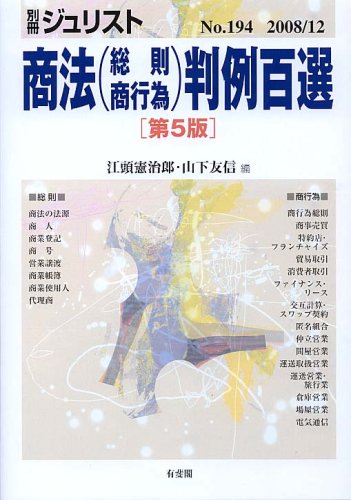273 0 0 0 ボーダレス化時代における法システムの再構築
今年度は、国家と社会、国際化と法、科学技術の発展と法の観点から第2期のまとめを行った。国家と社会に関しては、1.規範定立・執行における社会集団の役割(経済団体による法形成と執行、ドイツ医療保険法におけるFestbetragsfestsetzung制度、トランスナショナル社会運動)、2.市場と国家(政府業務の民間開放と法制度、株式会社・証券市場・市民社会、会社支配市場規制、ボーダレス化時代における租税制度)、3.ボーダレス時代における社会保障・安全確保・司法制度(社会保障法と憲法、警察行政における計画、関係性における暴力とその対応、司法の独立性)、4.国家財産法における公法と私法(政府業務の民間開放、韓国の国家財産法と法政策的課題)をまとめた。国際化と法に関しては、1.境界とは何か(生権力と国家、国境はなぜそしていかに引かれるべきか)、2.境界の変動および意味変容(国際法における境界の位相、国家の統合分裂とシティズンシップ)、3.変容する国際社会と法・政治の対応(パレスチナ問題と国際法、開発・エイズ・人権、経済連携協定、法整備支援)、4.人の国際移動と法・政治の対応(国際移住の法と法政策、民法における外国人問題、国際化と地方自治)をまとめた。科学技術の発展と法に関しては、1.科学技術と生命観(歴史的視座、動物観と法制度設計)、2.科学技術と制度(学問と法システム、リスク評価と法システム、予防原則)、3.科学技術と刑事法(現代型刑罰法規と罪刑法定主義、科学技術の進歩と刑法-過失責任)、4.科学技術と民事法(証券取引の電子化、無体化・電子化と占有概念、5.科学技術と国際法(非国家主体に対する軍備管理、国際環境法における科学技術と対話プロセス)を取りまとめた。なお、とりまとめの過程で2006年1月に国際シンポジウムを開催した。また、第1期の成果5巻も無事出版した。
3 0 0 0 OA 「買収プレミアム」と株式買取請求に係る「公正な価格」
- 著者
- 江頭 憲治郎
- 出版者
- 日本学士院
- 雑誌
- 日本學士院紀要 (ISSN:03880036)
- 巻号頁・発行日
- vol.77, no.3, pp.149-177, 2023 (Released:2023-05-12)
Ⅰ. Introduction In acquisitions of publicly traded companies, a “takeover premium” is usually paid to the shareholders of the target company, who are the sellers. If the consideration for the acquisition is cash, the acquirer makes a tender offer for the target company's shares, and the purchase price is often the market price of the target company's shares before the announcement of the acquisition plan plus an additional 30% or so, which is the takeover premium. If the consideration for the acquisition is shares issued by the acquirer (in the case of an acquisition through a merger or similar procedure), the merger ratio is often set in favor of the target company relative to the stock prices of the two companies before the announcement of the acquisition plan, which is the takeover premium. In a cash offer, the acquirer uses corporate law procedures to cash out shareholders who have not tendered their shares in the tender offer and remain in the target company, but the shareholders who are dissatisfied with the consideration delivered (which is the same amount as the purchase price in the tender offer) may petition the court to determine a “fair price” for the shares. In a merger or other acquisition in which shares are used as consideration, a shareholder who voted against the resolution approving the merger agreement may request the company to purchase his/her shares at a “fair price”. If the opposing shareholders and the company cannot reach an agreement on the purchase price, either party may petition the court to determine the purchase price. These rights are the appraisal rights. (View PDF for the rest of the abstract.)
2 0 0 0 OA 「外国会社」とは何か -持分会社に相当するものの場合-
- 著者
- 江頭 憲治郎
- 出版者
- 早稲田大学法学会
- 雑誌
- 早稲田法学 = THE WASEDA LAW REVIEW (ISSN:03890546)
- 巻号頁・発行日
- vol.83, no.4, pp.1-34, 2008-06-10
1 0 0 0 OA コーポレート・ガバナンスの目的と手法
- 著者
- 江頭 憲治郎
- 出版者
- 早稲田大学法学会
- 雑誌
- 早稻田法學 (ISSN:03890546)
- 巻号頁・発行日
- vol.92, no.1, pp.95-117, 2016-11-30
1 0 0 0 手形と小切手
- 著者
- 前田庸江頭憲治郎〔著〕
- 出版者
- 第一法規出版
- 巻号頁・発行日
- 1982
1 0 0 0 結合企業法の立法と解釈
- 著者
- 江頭憲治郎 [著]
- 巻号頁・発行日
- 1996
1 0 0 0 商法(総則商行為)判例百選
- 著者
- 江頭憲治郎 山下友信編
- 出版者
- 有斐閣
- 巻号頁・発行日
- 2008
1 0 0 0 講演 株価に関する支配権プレミアムとマイノリティ・ディスカウント
- 著者
- 江頭 憲治郎
- 出版者
- 東京株式懇話会
- 雑誌
- 東京株式懇話会会報 (ISSN:13435337)
- 巻号頁・発行日
- no.711, pp.2-28, 2010-12
